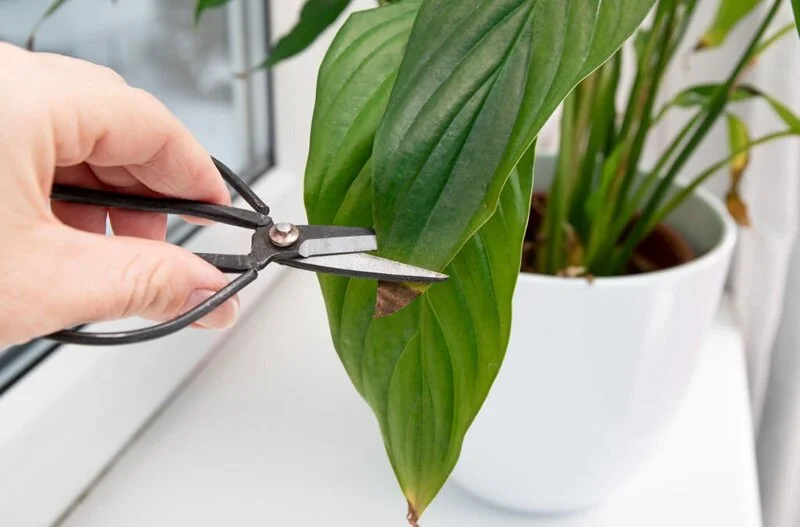When it comes to houseplants, peace lilies seem to have it all: they’re attractive, they thrive in low light, and they even manage to clean the air a little bit. They are a popular choice for both indoor and outdoor settings with to their glossy, dark-green leaves and beautiful, fragrant white blossoms. But what should you do if the lush leaves on your peace lily suddenly turn a concerning brown? This is a regular problem among peace lily owners and usually indicates that you need to make adjustments to how you’re caring for your plant. In this piece, we’ll investigate what’s causing your peace lily to turn brown and what you can do to bring it back to life.
Understanding Peace Lilies
Tropical rain forests in Central and South America are home to the plants known as peace lilies (Spathiphyllum spp.). Their distinctive white blossoms shine out magnificently against the dark green of their leaves, earning them widespread recognition. Peace lilies are widely grown as houseplants all around the world because of how well they do in artificial environments despite their exotic origins.
Peace lilies are tropical plants, therefore they thrive in hot, humid conditions. They thrive in indirect sunlight but are also able to function in low-light settings. However, its leaves easily scorch when exposed to strong sunshine. Soil that is regularly damp, but not soggy, is ideal. It’s important to remember that your particular peace lily type and the conditions in your home will affect its exact care requirements slightly.
Common Causes of Browning in Peace Lilies
Now, let’s explore why your peace lily’s leaves might be turning brown.
- Overwatering or Underwatering: One common cause is improper watering. Both too much and too little water can cause peace lily leaves to brown. Overwatering can lead to root rot, which in turn can cause browning leaves, while underwatering can lead to dehydration and subsequent browning.
- Exposure to Direct Sunlight: As mentioned earlier, peace lilies are not fans of direct sunlight. If your plant’s leaves are exposed to harsh, direct light, they might get sunburned, resulting in brown spots.
- Nutrient Deficiency: If your peace lily is not getting the nutrients it needs, its leaves may start to brown. This can happen if the plant has been in the same potting mix for a long time and has used up all available nutrients.
- Pest Infestation: Certain pests, like aphids or spider mites, can cause damage to peace lily leaves, leading to browning.
By understanding these common causes, you can better diagnose what’s happening when you see those alarming brown leaves. In the next sections, we’ll discuss how to identify the specific cause and the steps you can take to help your peace lily bounce back.
Diagnosing the Problem
Finding out what’s wrong with your peace lily and fixing it should be your first priority. Try to spot any additional indications of trouble. Overwatering can cause symptoms like yellowing and eventual browning of peace lily leaves. However, if the leaves on your plant are turning brown and crispy, you may not be watering it enough. Verify the leaf orientation as well. Curling inward of the leaves is a common sign of overexposure to light. The needs of your peace lily can be deduced from a thorough examination of the plant.
Solutions to Prevent and Treat Browning Peace Lily Leaves
Once you’ve diagnosed the issue, you can start to treat it. Here’s what you can do for each problem:
- For Overwatering or Underwatering: Make sure your peace lily’s soil is consistently moist, but not waterlogged. If the soil is too dry, water the plant thoroughly and let the excess drain off. If the soil is too wet, you might need to repot your peace lily in fresh, well-draining soil.
- For Exposure to Direct Sunlight: Move your peace lily to a spot that receives bright, indirect light. A north or east-facing window is typically a good choice.
- For Nutrient Deficiency: Refresh your peace lily’s soil with a high-quality potting mix, or use a balanced, slow-release fertilizer. Be careful not to overfertilize, as this can cause more harm than good.
- For Pest Infestation: Check the undersides of leaves and the base of the plant for pests. If found, remove them using a damp cloth, or use a suitable insecticidal soap or spray.
Remember, reviving a distressed peace lily can take time, so be patient and consistent in your care.
Conclusion
Seeing the leaves on your peace lily turn brown is upsetting, but you shouldn’t give up hope. Your peace lily can be revived to health if you identify the underlying source of the problem and treat it accordingly. Keep in mind that caring for plants typically requires some sleuthing and a lot of patience. So, maintain an attitude of curiosity, absorb new information, and develop as much as possible. Your peace lily will reward your patience and attention with glossy, green foliage and stunning flowers.



